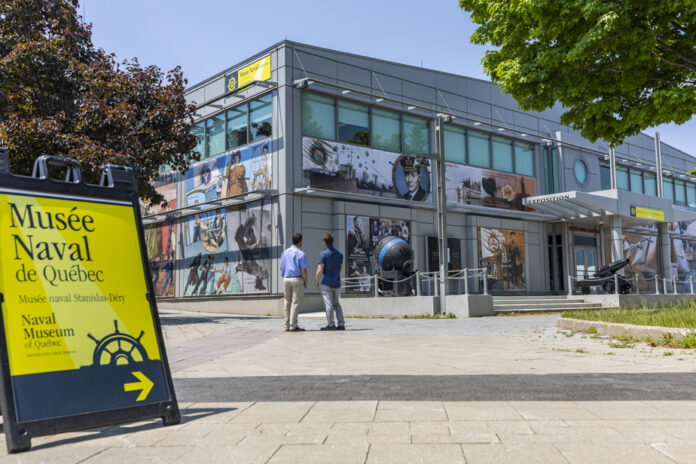Quebec visual artist Paul Abraham created a huge fresco on the facade of the Naval Museum of Quebec on the occasion of the centennial of the Naval Reserve of Canada. The 200 m long graphic work is inaugurated this Thursday in the port of Quebec.
The Naval Reserve of Canada, which comprises 24 divisions in major cities across the country, was created on January 31, 1923, shortly after the First World War, to provide a reserve of volunteer sailors. A sort of citizen navy, it meets the various needs of the Royal Canadian Navy. Today, more than 4,000 sailors work part-time for Canada’s Naval Reserve. They participate in relief operations during natural disasters (floods, forest fires) or help people in need, as we have seen during the COVID-19 pandemic.
To mark this centenary, the divisions of the Naval Reserve of Canada were called upon to organize activities. That of the Old Capital took advantage of the Naval Museum of Quebec, an official museum of the Canadian Armed Forces, which took the initiative to create a commemorative fresco. Quebec artist Paul Abraham was chosen last year to create this large-scale work.
Adorning the Pointe-à-Carcy naval complex at 170 Dalhousie Street, the fresco consists of 28 printed canvas panels affixed to the walls and windows of the museum, like the sails of a ship. The work evokes 100 years of Naval Reserve history with 245 figures in action.
Among them, Frédéric Rolette, a French-speaking sailor from Quebec and hero of the War of 1812. Or Pierre-Étienne Fortin, captain of the schooner La Canadienne, a famous sailboat armed for the protection of fishing nicknamed “the king of the Gulf “. We also find Winston Churchill and Franklin D. Roosevelt meeting at the Quebec Conference from August 17 to 24, 1943, to agree on a strategy for the war then raging in Europe.
To create this fresco – a work that lasted six months – Paul Abraham had access to the museum’s archives. He collaborated with Samuel Venière, project manager and historian of the museum, so that the fresco respects his vision, but also the expectations of the museum. For three months, he benefited from the help of his spouse, the artist and colorist Pascale Bourguignon.
The characters and elements that make up the fresco are both imposing and detailed. “I very quickly decided to produce the images directly on graphic tablets at real size, or at scale 1, to avoid the traditional process of reproduction on cardboard, says Paul Abraham. This gave an enormous surface to cover, even on a computer screen, but it avoided the various stages of tedious work, such as the projection reproduction of the original sketches on cardboard. »
The illustrations are reminiscent of a comic book. Born in Switzerland, Paul Abraham has a long experience of storytelling and heroic characters. He spent part of his childhood by the Mediterranean Sea. “My dad was a ship’s doctor on cruise ships,” he says. I have shared his travels a few times, which are at the origin of my attraction to the maritime world. »
The plunge into history represented by this project had attracted the artist. “I saw a similarity to the projects assigned to Renaissance and Baroque artists,” he says. I don’t compare myself to the old masters, of course, but for me it was like paying homage to these artists who have always fascinated me. The Renaissance – Botticelli, Vinci, Michelangelo – and Baroque art [Vélasquez, Caravaggio and Bernini] have had an influence on my work. I often refer to it through the attitudes of the characters and the compositions. »
The artist first submitted the sketches for the panels to the museum for approval. It is interesting to note the progress of the work, from the sketch to the final rendering by contemplating canvases 25 and 26.
Paul Abraham is very happy to have produced a work that will have great visibility, the Port of Quebec being visited by 600,000 people each year. If you have the wings of an angel, then it’s time to leave for Quebec and admire this tribute to an institution and to the men and women who have chosen for 100 years to give their time to support the others. The art and help of therapy…















